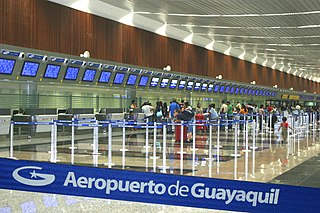
TAME or TAME EP Linea Aerea del Ecuador was an airline founded in Ecuador in 1962. TAME was the flag carrier and the largest airline of Ecuador. TAME headquarters were in Quito, Pichincha Province and the main hub was Mariscal Sucre International Airport in Quito. The airline was formed by the Air Force of Ecuador. In 2011, it became a commercial entity and provided domestic, international and charter flights. On May 20, 2020, the Ecuadorean government decided to cease all operations and liquidate the airline.
This is a list of aviation-related events from 1977.
This is a list of aviation-related events from 1978.
This is a list of aviation-related events from 1979.

José Joaquín de Olmedo International Airport is an international airport serving Guayaquil, the capital of the Guayas Province and the most populous city in Ecuador. It is the second busiest airport in Ecuador.

Alfonso Bonilla Aragón International Airport, formerly known as Palmaseca International Airport, is an international airport located between Palmira and Cali, the capital of Valle del Cauca Department, Colombia. It is Colombia's fourth-busiest airport in passenger volume, with 5,600,000 people using the airport in 2016, and the third largest in area and construction. The airport often serves as the alternate airport for Bogotá - El Dorado Int'l Airport and other Colombian airports.

The Fairchild F-27 and Fairchild Hiller FH-227 were versions of the Fokker F27 Friendship twin-engined, turboprop, passenger aircraft manufactured under license by Fairchild Hiller in the United States. The Fairchild F-27 was similar to the standard Fokker F27, while the FH-227 was an independently developed, stretched version.

Empresa Ecuatoriana de Aviación, more commonly known as simply Ecuatoriana, was the national airline of Ecuador. The carrier had an operational hiatus between September 1993 and August 1995, resuming operations on 23 June 1996, after VASP became the controlling shareholder. The airline folded permanently in 2006.

Icaro Air was an airline based in Quito, Ecuador. Its main base was Mariscal Sucre International Airport, Quito.
Intercontinental de Aviación S.A. was an airline based in Bogotá, Colombia. It operated domestic services and flights to neighboring countries. Its main hub was located at El Dorado International Airport in Bogotá, with a secondary hub at Alfonso Bonilla Aragón International Airport in Cali. The airline closed operations in 2005.

Mariscal Sucre International Airport(IATA: UIO, ICAO: SEQU) was the main international airport that served Quito, Pichincha, Ecuador. It was the busiest airport in Ecuador by passenger traffic, by aircraft movement and by cargo movement, and one of the busiest airports in South America. It was named after Venezuelan-born Antonio José de Sucre, a hero of Ecuadorian and Latin American independence. It began operations on August 5, 1960, and during its last years of operation, handled about 6.2 million passengers and 164,000 metric tons of freight per year. The airport, one of the highest in the world was located in the northern part of the city, in the Chaupicruz parish, within five minutes of Quito's financial center; the terminals were located at the intersection of Amazonas and La Prensa avenues. Mariscal Sucre International was the largest hub for TAME with an average of 50 daily departures.

SAETA Flight 011 was a scheduled passenger flight operated by SAETA Air Ecuador between Quito and Cuenca, using a Vickers Viscount 785D aircraft. On 15 August 1976, the flight was reported missing near the Chimborazo stratovolcano while carrying 55 passengers and four crew members. Searches for the plane would be carried out for 26 years, until the wreckage of the aircraft was officially located in February 2003.

Mariscal Lamar International Airport is a high elevation airport serving Cuenca, the capital of the Azuay Province in Ecuador. It is named after the Peruvian military leader and politician José de la Mar, a native of Cuenca.
SAN was an airline which was based in Guayaquil, Ecuador that was the domestic branch of the airline SAETA. It was founded in 1964, and ceased operations in 1999.

TAME Flight 173, a Boeing 737-2V2 Advanced operated by Ecuador's national airline TAME, flying on a domestic route from the now-closed Mariscal Sucre International Airport in Quito to Mariscal Lamar International Airport in Cuenca, crashed on 11 July 1983 into a hill during final approach just 1 mile from its final destination, killing all 119 people on board.
Avianca Ecuador S.A. is an airline based in Quito, Ecuador. It operates passenger and cargo flights within Ecuador, between the mainland and the Galápagos Islands, and between Ecuador and Colombia. It is one of the seven nationally branded airlines in the Avianca Group of Latin American airlines.

Mariscal Sucre International Airport is an international airport serving Quito, Ecuador. It is the busiest airport in Ecuador. It is located in the Tababela parish, about 18 kilometres (11 mi) east of Quito, and because of its location it is also colloquially known as Tababela Airport. The airport currently serves as the main hub for Avianca Ecuador and the largest hub for LATAM Ecuador. It also served as the main hub for TAME, Ecuador's flag-carrier, before the airline was liquidated by the Ecuadorian government in 2020. The airport opened in February 2013 and replaced the 53-year old airport of the same name. The airport is named after independence leader Antonio José de Sucre. It was the first 5-star airport in the Western Hemisphere as rated by Skytrax.

On 23 April 1979, SAETA Flight 011, a Vickers Viscount passenger aircraft of Ecuadorian airline SAETA, crashed in a mountainous region of Pastaza Province, Ecuador, killing all 57 people on board. The wreckage of the aircraft was not found until five years later.














